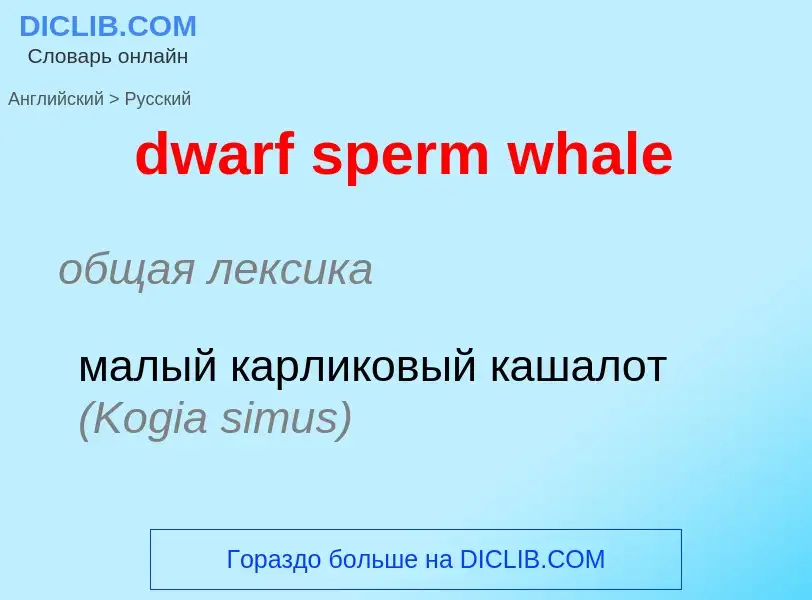Vertaling en analyse van woorden door kunstmatige intelligentie ChatGPT
Op deze pagina kunt u een gedetailleerde analyse krijgen van een woord of zin, geproduceerd met behulp van de beste kunstmatige intelligentietechnologie tot nu toe:
- hoe het woord wordt gebruikt
- gebruiksfrequentie
- het wordt vaker gebruikt in mondelinge of schriftelijke toespraken
- opties voor woordvertaling
- Gebruiksvoorbeelden (meerdere zinnen met vertaling)
- etymologie
dwarf sperm whale - vertaling naar russisch
общая лексика
малый карликовый кашалот (Kogia simus)
зоология
кашалот (Physeter catodon)
Definitie
Wikipedia
.jpg?width=120)
The dwarf sperm whale (Kogia sima) is a sperm whale that inhabits temperate and tropical oceans worldwide, in particular continental shelves and slopes. It was first described by biologist Richard Owen in 1866, based on illustrations by naturalist Sir Walter Elliot. The species was considered to be synonymous with the pygmy sperm whale (Kogia breviceps) from 1878 until 1998. The dwarf sperm whale is a small whale, 2 to 2.7 m (6 ft 7 in to 8 ft 10 in) and 136 to 272 kg (300 to 600 lb), that has a grey coloration, square head, small jaw, and robust body. Its appearance is very similar to the pygmy sperm whale, distinguished mainly by the position of the dorsal fin on the body–nearer the middle in the dwarf sperm whale and nearer the tail in the other.
The dwarf sperm whale is a suction feeder that mainly eats squid, and does this in small pods of typically one to four members. It is preyed upon by the killer whale (Orcinus orca) and large sharks such as the great white shark (Carcharodon carcharius). When startled, the whale can eject a cloud of red-brown fluid. Most of what is known of the whale comes from beached individuals, as sightings in the ocean are rare. Many of these stranded whales died from parasitic infestations or heart failure.
The dwarf sperm whale is hunted in small numbers around Asia. It is most threatened by ingesting, or getting entangled by, marine debris. No global population estimate has been made, and so its conservation status by the International Union for Conservation of Nature (IUCN) is least concern.

.jpg?width=200)



![[[Ambergris]] [[Ambergris]]](https://commons.wikimedia.org/wiki/Special:FilePath/Ambergris.jpg?width=200)

![[[Scrimshaw]] was the art of engraving on the teeth of sperm whales. It was a way for whalers to pass the time between hunts. [[Scrimshaw]] was the art of engraving on the teeth of sperm whales. It was a way for whalers to pass the time between hunts.](https://commons.wikimedia.org/wiki/Special:FilePath/Nantucket Whaling scrimshaw E.Burdett.jpg?width=200)


![Unusual among [[cetaceans]], the sperm whale's blowhole is highly skewed to the left side of the head. Unusual among [[cetaceans]], the sperm whale's blowhole is highly skewed to the left side of the head.](https://commons.wikimedia.org/wiki/Special:FilePath/Sperm whale blowhole Vincze.jpg?width=200)

.jpg?width=200)



.jpg?width=200)

![sound mirror]]. sound mirror]].](https://commons.wikimedia.org/wiki/Special:FilePath/Sperm whale frontal sac surface close-up.jpg?width=200)
